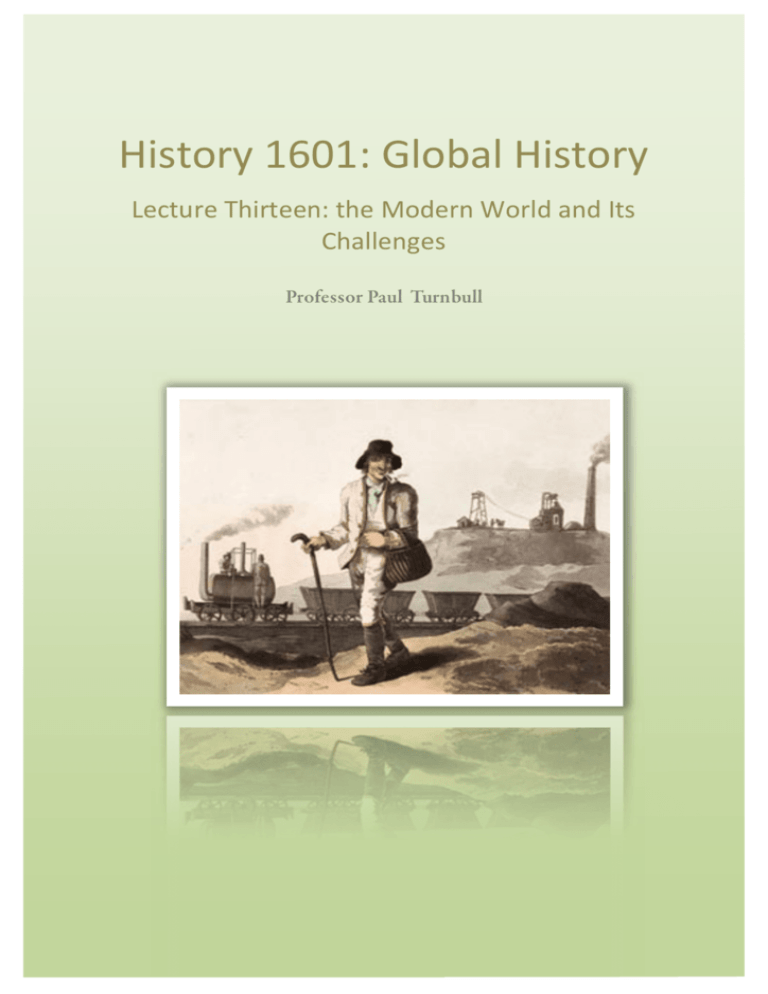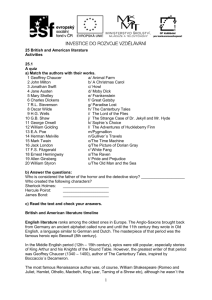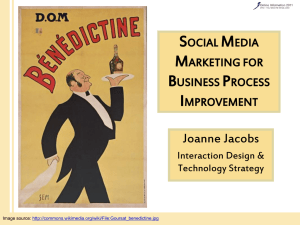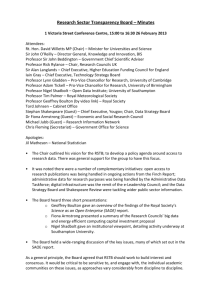Transcript of this week's podcast
advertisement

!"#$%&'()*+),(-.%/0.(!"#$%&'( 123$4&2(56"&$227,($62(8%92&7(:%&.9(079(;$#( <60..27=2#( Professor Paul Turnbull " ! When we situate the course of human history over the 250 years within the time-scale of our history over the past 250,000 years it becomes strikingly evident how the ways in which we live have changed since the late eighteenth century CE. The changes have been connected with and for the most part caused by the emergence of a modern form of society reflecting the primarily importance of industrial production. This mode of production has been capitalist – that is to say it has involved the means of production becoming increasingly concentrated in the hands of private owners, who have sought to use their ownership to maximize their profit. Private ownership of the means of production has been accompanied by a the bulk of the state’s population having no means to obtain the essentials of life but by selling their labour power to those who need it to exploit their ownership of the means of production. This transition to reliance on industrial production began in Western Europe during the latter part of the eighteenth century. We find it first successfully employed on any significant scale in England, where fossil fuel powered machinery was employed in the manufacture of textiles and other consumer goods. We can get a good idea of how this transition occurred by looking at one English entrepreneur, Matthew Boulton (1728-1809) and his pioneering of the mechanized production of consumer goods and industrial machinery. 1 Boulton started his working life working in a small buckle-making business in Birmingham, in England’s midlands. Birmingham was to become a major industrial centre from the end of the eighteenth century; but when Boulton started learning how to make buckles for shoes and belts at the age of fourteen (in 1742), it was a prosperous agricultural market town, but one in which farming tools and other metal wares had been important activities since the early seventeenth century, due to its proximity to easily minable iron ore and coal deposits. Figure 1: Matthew Boulton, circa 1790. Engraving by William Ridley (1764-1834). Public domain image, http://commons.wikimedia.org/wiki/File:Mat thew_Boulton02.jpg 1 H. W. Dickinson and James Watt, Matthew Boulton (Cambridge: Cambridge University Press, 1936). See also Jennifer Tann, “Boulton, Matthew (1728–1809),” in Oxford Dictionary of National Biography, ed. H. C. G. Matthew and Brian Harrison (Oxford: OUP, 2004); online ed., ed. Lawrence Goldman, May 2007, http://www.oxforddnb.com/view/article/2983 (accessed May 13, 2010). ! Figure 2: Matthew Boulton's Soho manufactory, http://commons.wikimedia.org/wiki/File:Sohomanuf.jpg # opened in 1766. Public domain image, Until the late eighteenth century, however, ironware was produced in small family-owned workshops, using iron produced in small furnaces that were also family businesses. When Boulton began making buckles, for example, he did so working in a business run by his father that mostly employed relatives or men and women from neighbouring families. The Boulton family were nonconformist Protestants, who saw advances in science and technology as produced by God’s bestowal of reasoning powers on humanity to benefit themselves and their fellow beings both socially and morally. The young Boulton was especially fascinated by new technologies and well before he took over running the family business in 1760, it had diversified into making range steel, enamel and ceramic employing new work practices and coal powered machinery. The new work practices Boulton instituted were those which thereafter typified industrial production. Rather than having one or two skilled workers making an object, the creation of the object was broken down into a series of processes, involving a number of workers. Some processes, such as painting designs on enamel buttons or ceramics, required considerable expertise, while fashioning the individual components making up a button or vase combining steel and ceramics required less skill. Boulton found that by organizing the manufacture of goods in a series of successive processes undertaken by different people, the rate of producing these goods was faster, and less costly than having one or two people undertake every step in making them. This meant he could sell what was produced at a lower price than his competitors while gaining the same or a greater profit. By investing his profit into hiring more workers and pursuing further technological innovations he could not only produced a greater volume of goods at $ ! attractive prices, but also could sell them to merchants, who would than sell them in other English and continental European centres, while still gaining a good profit. By the late 1760s Boulton had transformed a manufacturing business that for several generations had operated in workshops adjacent the family house into an enterprise carried on in several purpose built “manufactories.” Boulton had also begun mass-producing luxury furniture, table decorations and clocks for wealthy English landowners, merchants and a growing number of manufacturers who were similarly profiting from adopting methods of mass production. However, interestingly, Boulton’s venturing into the mass production of luxury items was unsuccessful, because those who could afford to buy these goods preferred to spend more money on commissioning craftsmen to make them unique items. Owning a unique item that could be prominently displayed in their homes or on their person so as to be admired by visitors was more powerfully symbolic of their wealth and social standing than something that many of their peers might own. Where Boulton enjoyed greater Figure 4: Ormulu tea urn manufactured by Boulton, success was with cheaper, mass-produced early 1770s. Creative Commons image , http://commons.wikimedia.org/wiki/File:Ormolutea items for every day use that ordinary urn.JPG people could afford. He also profited from going into partnership with James Watt (1736-1819), a Scots engineer and inventor who radically improved the design of a coal fired pump engine that had been used in parts of Britain since the early years of the eighteenth century to drain water from underground coal mines. Boulton and Watt went into partnership building and selling Watt’s improved engine to the owners of tin mines in Cornwall. Tin had been mined in this southwest region of England since at least the third century CE. But by the early eighteenth century the most lucrative ore seams lay below the surrounding water table. Figure 3: Boulton and Watt engine, 1784. Public domain image, http://commons.wikimedia.org/wiki/File:SteamEngi ne_Boulton%26Watt_1784.jpg ! % By the 1780s, the Watt engine was also being used to automate cotton spinning – with the result that cotton cloth could be produced in much greater quantities at cheaper prices returning higher profits. Moreover, from the 1760s Boulton was active in Birmingham politics and a firm supporter of structural reforms that would enable the industrialization of industry as he had pioneered it. I have briefly sketched the achievements of Matthew Boulton because they so typical of the first generations of European commercial entrepreneurs who pioneered industrial mass production – a form of production which by its development from the second half of the eighteenth century was to transform our world, and to do so in large measure by the Figure 5: Richard Arkwright's water (spinning) frame, 1768. By the political and 1780s larger versions of the frame were powered by steam engines. economic, GFDL licensed image, military strength it gave http://en.wikipedia.org/wiki/File:Waterframe.jpg European states. In terms of the span of human history, the development of industrial capitalism rapidly made Europe the centre of gravity within the world system of commercial exchange. How momentous the scale and speed of this transformation was can be gauged by considering the work of Daniel Headrick, an American social historian, who has sought to map the development manufacturing and technological change world since around 1700. Using his own and estimates by other historians of the scale of both household-based and industrial manufacturing over the past three hundred years, Headrick has developed an index of total industrial potential. 2 2 Daniel R. Headrick, The Tentacles of Progress : Technology Transfer in the Age of Imperialism, 1850-1940 (New York ; Oxford: Oxford University Press, 1988). Also Headrick's essay, "technological Change" in B. L. Turner, The Earth as Transformed by Human Action : Global and Regional Changes in the Biosphere over the & ! You will find a table illustrating the world’s total industrial potential between 1750-1980 on page 407 of David Christian’s Maps of Time. If you can, consult table now. You will see that taking Britain’s industrial potential Figure 6: "Poverty and Wealth", painted in 1888 by William Powell Frith. Public as a baseline and giving domain image, http://commons.wikimedia.org/wiki/File:William_Powell_Frith_- it a value of 100, we Poverty and Wealth.JPG can represent the industrial potential of China and India in 1750 as a value of 93, while that of Europe excluding Russia, the US and Japan is just 14. The potential of Asia was just over six and a half time greater than that of Europe. However, by 1900 the potential of Europe was 222, while of Asia was now 60 - in large part due to effects of European exploitation and control of Asian production and commercial activity. We will discuss this industrial potential index further in our classes this week. Suffice it to say here that they vividly illustrate the transformation affected by Europe’s industrial transformation, and help us understand how European states came to dictate the course of world history from the early nineteenth century. Industrialized mass production first emerged on any significant scale in England, for reasons we have discussed in this and previous lectures. However, by the 1840s, industrialized production was occurring on scales that were motivating changes in social and political structures in western and central Europe. Many courses on modern European history examine the revolutions that occurred in numerous European states in 1848. These revolutions came about because of combination of factors. The years immediately preceding 1848 were years of poor harvest – again illustrating how significant a factor climate has been in human history. Poor harvests meant increased food prices. Higher food prices meant less income to purchase manufactured goods and services that led traditional small-scale and industrial manufacturers scaled back production. In the case of household based manufacturers, workers generally continued to Past 300 Years (Cambridge ; New York: Cambridge University Press with Clark University, 1990), pp. 55-67. ! ' work for less or no more than food and lodging. Those employed by industrial manufacturers workers were dismissed and left to survive as best they could. Figure 7: Painting of Battle at Soufflot barricades at Rue Soufflot Street, Paris, on 24 June 1848 by Emile Vernet (1789-1863). Public domain image, http://commons.wikimedia.org/wiki/File:Horace_VernetBarricade rue Soufflot.jpg The revolutions of 1848 gained much of their momentum from peasant unrest and resistance on the part of ruling elites to demands by owners of manufacturing and other commercial enterprises for greater participation in the governance of the state. But what was also a significant cause of revolutionary upheaval across continental Europe was that thousands of industrial workers lost their only source of income. Arguably the most influential political work published in the nineteenth century was Karl Marx and Friedrich Engel’s pamphlet, entitled, The Communist Manifesto. It was published in England in February 1848; but addressed workers throughout Europe. It is worth taking some time to read this pamphlet, because it gives a vivid illustration of the new kinds of political thought that were emerging in reaction to the miseries that economic depression and the reduced industrial production were causing in Europe by the midnineteenth century. ( ! What is more, we can see that many of the social and political reforms that occurred in Europe over the following half-century or so were to reflect the concern of European rulers, owners of the means of production and those whose labour they purchased to ensure that what happened in 1848 would never occur again. We can also see that by the 1870s the emergence of new, large states in Italy and central Europe owed much to the development of industrial production and its acceleration of commercial activity. From the 1870s, growth in industrial production, notably in England, Germany and the US stimulated technological innovations that boosted productivity and levels of capital Figure 8: title page of the first edition of the available for investment in new enterprises. Communist Manifesto, London, 1848. GFDL licensed image, http://commons.wikimedia.org/wiki/File:C Advances in organic chemistry enhanced not ommunist-manifesto.png only the profitability of manufacturing, but also the productivity of agriculture. Electricity had been a source a curiosity as early as 1000 BCE, but in the early 1820s it was realized that electrical energy could be used to power machinery; and by the 1890s, electric motors were being used to power vehicles and beginning to be used to power industrial machinery. By the 1890s, electric lights were also contributing to increased productivity by providing brighter and consistent lighting than gas lamps could in factories. Figure 9: electric trams, Vancouver, Canada, 1910. Public domain image, http://commons.wikimedia.org/wiki/File:BC_Electric_trolley_buses_1910.jpg ! ) By the early twentieth century, European states and the United States had government agencies to facilitate the strategic growth of industrially based manufacturing and commerce. The industrial transformation of Europe and the United States were to have detrimental effects on commercial activity in Asia. Industrially produced goods could be produced at costs that allowed them to be sold within Asian markets at prices that local manufacturers could not match. But often the worst effects of Europe and the United States’ economic power flowed from the political and political industrialism gave them. In India, for example, growing cotton had sustained peasant families for countless generations. It had been the basis of household-based manufacturing and generated wealth through its commercial exchange. However, as British production of cotton goods grew in volume, that state’s commercial entrepreneurs and, from the early 1860s, its government, aggressively imposed policies that undermined local cotton production to the point that tens of thousands of people could no longer live by manufacturing, trading or selling cotton textiles. Equally being forced to sell the cotton to local elites acting on behalf of British manufacturers at outrageously low prices impoverished peasant growers – and led to many families suffering malnutrition and premature death. The situation by the mid-nineteenth century was well summarized by Mohandas Karamchand Gandhi, the great Indian anti-colonial politician and spiritual leader: 1. English people buy Indian cotton in the field, picked by Indian labor at seven cents a day, through an optional monopoly. 2. This cotton is shipped on British ships, a three-week journey across the Indian Ocean, down the Red Sea, across the Mediterranean, through Gibraltar, across the Bay of Biscay and the Atlantic Ocean to London. One hundred per cent profit on this freight is regarded as small. 3. The cotton is turned into cloth in Lancashire. You pay shilling wages instead of Indian pennies to your workers. The English worker not only has the advantage of better wages, but the steel companies of England get the profit of building the factories and machines. Wages; profits; all these are spent in England. 4. The finished product is sent back to India at European shipping rates, once again on British ships. The captains, officers, sailors of these ships, whose wages must be paid, are English. The only Indians who profit are a few lascars who do the dirty work on the boats for a few cents a day. 5. The cloth is finally sold back to the kings and landlords of India who got the money to buy this expensive cloth out of the poor peasants of India who worked at seven cents a day. *+ ! Similarly, in China, first Britain and then other European powers gained what they Figure 10: Gandhi during the Salt Protests, 1930. Note the wearing of simple home spun cloth. Public domain image, http://commons.wikimedia.org/wiki/File:Gandhi_during_the_Salt_March.jpg termed “commercial concessions” from that state’s rulers. By the early twentieth century, European domination of China’s economy and politics were causing the disintegration of the state and into areas carved out and controlled by local landowners with the wealth to raise private armies. However, the detrimental effects of this industrially driven transformation of our history were not entirely due to human agency. I mentioned earlier in this lecture that climate was an indirect yet significant factor in revolutions occurring across continental Europe in 1848. Climate also helped accelerate the degree of control European states gained over the economies and political structures of Asian states. In the late 1870s, the equatorial and subequatorial regions of the earth were subject to several years of extreme drought caused by the warming of Pacific and Indian Ocean temperatures. In India food crops on which nearly 60 million people depended on failed between 1876-8. It has been estimated that somewhere between 6 and 210 million people died of starvation – with the result that many local economies and larger networks of commercial exchange collapsed. In northern China, much the same tragedy occurred. It has been estimated that up to 13 million people died of starvation and disease. What is more, the ability of the Chinese state to intervene to control food stocks and distribute food was weaker than it was in India. This ! ** and the effects of famine on manufacturing and commercial exchange all served to weaken further the already severely declining authority of the Chinese state. Towards the end of the chapter in his Maps of Time entitled, “Birth of the Modern World”, David Christian points out that by the end of the nineteenth century the rulers of tributary states beyond Europe were confronted with the reality that the only path to escaping European domination and achieving future economic and social stability lay in 3 industrialization. Moreover, the transition to modernity by some European states, notably Germany, Figure 11: depiction of Indian Famine of 1877 in London Illustrated News. Public domain image, gave reason to think that http://commons.wikimedia.org/wiki/File:Famine_in_India_Natives_Waiti ng_for_Relief_in_Bangalore.jpg this might be done without endangering their rule. In Germany, industrialism had been achieved while consolidating the power of Prussia’s feudal aristocracy and ruling dynasty within the new German Reich. The Meiji period in Japan between 1868-1912 CE saw that the emergence of a state with the structural framework necessary to support an industrial capitalist economy by the early 1890s. Modernization was aided by widespread employment of European expertise to advise on economic development, science and technology. Japan’s ruling elite during the Meiji period’s financing and support of industrialization greatly aided the emergence of powerful new industrial monopolies – which were to have great influence in Japanese domestic politics, foreign policy and the development of colonial ambitions in eastern and south East Asia. However, other states were less successful in pursuing modernity until the second half of the twentieth century. China was to experience further economic decline and political 3 David Christian, Maps of Time: An Introduction to Big History (Berkeley: California University Press, 2005), pp. 436-7. ! *" chaos until the end of the Second World War, when the Communist Party emerged the victor of civil war in the aftermath of Japanese occupation and determinedly embarked on making China a leading industrial power. Incidentally, we can understand, even if we disagree, with China’s current leadership in resolutely challenging the right of western states and media to make critical comments on its domestic affairs matters, when we take account of how European states came to dominate and control China’s economic and politics from the 1840s to the establishment of the Peoples’ Republic in 1949. Figure 12: Late 19th century French cartoon of European powers and Japan "carving up" China. Public domain image, http://www.knowledgerush.com/wiki_image/3/32/China_imperialism_c artoon.jpg Before concluding this lecture, it is necessary to draw attention to how the twentieth has not simply been an age of industrially-powered change, but one in which the speed and scale of change experienced by people throughout the world has got progressively faster. This has largely been due to astonishing rates of technological change, which have greatly increased agricultural productivity, the volume of industrial production, and the development new forms of electronic communication giving an ever increasing proportion of the world’s population the ability easily to create, rapidly disseminate and use information. Today we often use the terms “first” and “third” world as convenient shorthand when discussing the wide disparity in living standards and health between those living in Europe or European settler colonies and people in Africa and many parts of Asia. This disparity had clearly emerged by the end of the nineteenth century, bequeathing we who live in the early twenty-first century one of most intractable problems. ! *# Figure 13http://upload.wikimedia.org/wikipedia/commons/a/a6/Percent_poverty_world_map.png: world populations showing percentage of per capita income below US poverty line in 2008. Source: CIA World fact Book 2008. Public domain image, Bibliography Christian, David. Maps of Time: An Introduction to Big History. Berkeley: California University Press, 2005. Dickinson, H. W., and James Watt. Matthew Boulton. Cambridge: Cambridge University Press, 1936. Headrick, Daniel R. The Tentacles of Progress : Technology Transfer in the Age of Imperialism, 1850-1940. New York ; Oxford: Oxford University Press, 1988. Turner, B. L. The Earth as Transformed by Human Action : Global and Regional Changes in the Biosphere over the Past 300 Years. Cambridge ; New York: Cambridge University Press with Clark University, 1990.





